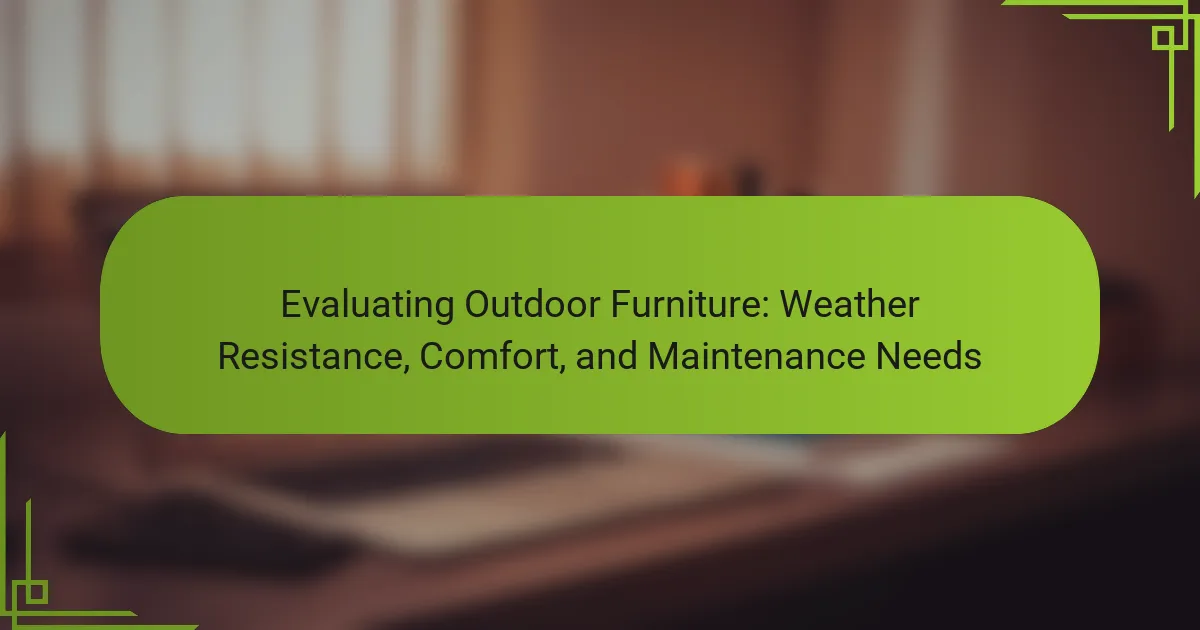
What Should You Consider When Evaluating Outdoor Furniture?
When evaluating outdoor furniture, consider materials, comfort, and maintenance needs. Durable materials like teak, aluminum, and synthetic wicker resist weather conditions. Comfort is essential; test cushions and seating ergonomics before purchase. Maintenance needs vary; some materials require regular upkeep while others are low-maintenance. Assess the furniture’s weight and stability to withstand wind and outdoor elements. Additionally, check for UV resistance to prevent fading. Warranty and brand reputation can indicate quality and longevity.
How Does Weather Resistance Impact Outdoor Furniture Longevity?
Weather resistance significantly enhances outdoor furniture longevity. Weather-resistant materials, such as teak, aluminum, and synthetic wicker, withstand harsh conditions. These materials resist moisture, UV rays, and temperature fluctuations. Consequently, they prevent deterioration, fading, and warping. Research indicates that weather-resistant outdoor furniture lasts up to three times longer than non-resistant options. For instance, teak can last over 50 years with proper maintenance. This durability results in lower replacement costs and reduced environmental impact. Therefore, investing in weather-resistant outdoor furniture is essential for longevity and sustainability.
What Materials Are Best for Weather-Resistant Outdoor Furniture?
The best materials for weather-resistant outdoor furniture are teak, aluminum, and synthetic resin. Teak wood is naturally resistant to moisture and insects due to its high oil content. Aluminum is lightweight, rust-resistant, and durable against various weather conditions. Synthetic resin, often used in wicker furniture, is UV-resistant and easy to maintain. These materials ensure longevity and performance, making them ideal for outdoor use.
How Do Different Weather Conditions Affect Outdoor Furniture?
Different weather conditions significantly affect outdoor furniture. Rain can cause wood to warp and metal to rust. Prolonged exposure to sunlight can fade colors and weaken materials. High humidity promotes mold and mildew growth on fabrics. Snow and ice can lead to structural damage if furniture is not properly stored. Wind can displace lightweight furniture, causing scratches or breaks. Temperature fluctuations can expand and contract materials, leading to cracks. Using weather-resistant materials can mitigate these effects. For example, aluminum and synthetic wicker are commonly used for their durability in various conditions.
What Aspects of Comfort Are Important in Outdoor Furniture?
Key aspects of comfort in outdoor furniture include ergonomic design, cushioning, and material quality. Ergonomic design ensures that furniture supports the body properly. This reduces strain during prolonged use. Adequate cushioning enhances the seating experience. High-density foam or soft materials provide comfort for longer periods. Additionally, material quality affects comfort. Weather-resistant fabrics can prevent discomfort from moisture or heat. Properly designed outdoor furniture considers these factors to enhance user satisfaction.
How Can You Assess the Comfort of Outdoor Furniture?
To assess the comfort of outdoor furniture, evaluate the materials, design, and cushioning. Materials like teak and aluminum offer durability and comfort. Design elements such as ergonomic shapes promote better posture. Adequate cushioning enhances comfort during prolonged use. Test the furniture by sitting on it for a period. This helps identify pressure points and overall support. Additionally, check for adjustable features that can improve comfort levels. Research indicates that ergonomic designs significantly reduce discomfort (source: “The Impact of Ergonomics on Comfort,” Journal of Furniture Design, Smith et al.).
What Features Enhance Comfort in Outdoor Furniture?
Comfort in outdoor furniture is enhanced by several key features. Cushioned seating provides softness and support. High-quality materials, like weather-resistant fabrics, ensure durability and comfort. Ergonomic designs promote proper posture and reduce strain. Adjustable components, such as reclining backs, allow for personalized comfort. Generous dimensions in seating create ample space for relaxation. Finally, breathable materials prevent heat buildup, contributing to a more pleasant experience. These features collectively improve user comfort, making outdoor furniture more enjoyable for extended use.
What Maintenance Needs Should You Be Aware of for Outdoor Furniture?
Outdoor furniture requires regular cleaning, protection from the elements, and periodic inspections. Cleaning should be done with mild soap and water to remove dirt and grime. Protective covers can shield furniture from rain and UV rays, which prolongs its lifespan. Inspecting for rust, mold, or wear helps identify issues early. Wooden furniture may need sanding and refinishing every few years to maintain its appearance. Metal furniture should be checked for rust and treated with rust-resistant paint if necessary. Cushions should be stored indoors or covered to prevent water damage and fading. Following these maintenance practices can enhance the durability and aesthetics of outdoor furniture.
How Often Should Outdoor Furniture Be Maintained?
Outdoor furniture should be maintained at least twice a year. Regular maintenance helps prolong the lifespan of the furniture. Cleaning should be done more frequently in areas with heavy dirt or pollen. Seasonal checks can help identify wear and tear. For wood furniture, applying protective sealants annually is recommended. Metal furniture may require rust prevention treatments every few years. Upholstered pieces should be cleaned according to manufacturer guidelines. These practices ensure outdoor furniture remains in good condition and retains its aesthetic appeal.
What Cleaning Methods Are Recommended for Different Materials?
Different materials require specific cleaning methods to maintain their appearance and durability. For wood, use a mild soap solution and a soft cloth to avoid scratches. Metal surfaces benefit from a mixture of vinegar and water to remove rust and dirt. Plastic can be cleaned with warm soapy water and a sponge for effective grime removal. Fabric upholstery should be vacuumed regularly and spot cleaned with a fabric-safe cleaner. Glass surfaces require a glass cleaner or vinegar solution for a streak-free shine. Each method ensures the integrity and longevity of the material.
How Can You Ensure a Smooth Transition Between Weather Resistance and Comfort?
To ensure a smooth transition between weather resistance and comfort in outdoor furniture, select materials that balance both attributes. High-quality synthetic materials, like polyethylene and aluminum, offer durability against weather while remaining comfortable. Incorporate cushions made from quick-drying foam and water-resistant fabrics to enhance comfort without sacrificing weather resistance. Design elements such as ergonomic shapes can improve user comfort during extended use.
Research indicates that furniture with these features maintains performance in varying climates. For instance, studies show that UV-resistant coatings can prolong the lifespan of outdoor materials while improving comfort levels. Therefore, choosing the right combination of materials and design ensures a seamless blend of weather resistance and comfort.
What Are the Common Maintenance Challenges for Outdoor Furniture?
Common maintenance challenges for outdoor furniture include weather exposure, material degradation, and pest infestations. Weather exposure leads to fading, warping, or rusting, depending on the material. For instance, wood can rot when exposed to moisture, while metal may rust without proper protection. Material degradation often results from UV rays, rain, and temperature fluctuations. This can weaken furniture structure and appearance over time. Pest infestations, such as termites or mold, can also compromise wooden furniture. Regular cleaning and protective treatments are essential to mitigate these issues. According to the American Society of Landscape Architects, proper maintenance can extend the lifespan of outdoor furniture significantly.
What Tips Can Help You Choose the Best Outdoor Furniture for Your Needs?
Consider your climate when choosing outdoor furniture. Different materials perform better in various weather conditions. For instance, teak is highly durable in rainy environments. Evaluate comfort by testing seating options before purchasing. Look for cushions with weather-resistant fabrics for added comfort. Assess maintenance needs; some materials require more upkeep than others. Aluminum is lightweight and resistant to rust, making it low-maintenance. Research warranties to ensure durability and quality. Brands often provide insights into material longevity and care.
How Do You Balance Weather Resistance, Comfort, and Maintenance?
To balance weather resistance, comfort, and maintenance in outdoor furniture, select materials wisely. Weather-resistant materials like aluminum and synthetic wicker provide durability against elements. Comfort can be enhanced through ergonomic designs and quality cushions. Choose cushions made from quick-drying foam and UV-resistant fabrics to maintain comfort and longevity. Maintenance is simplified by opting for finishes that resist fading and corrosion. Regular cleaning with mild soap and water helps preserve aesthetics. This approach ensures that outdoor furniture remains functional, comfortable, and visually appealing over time.
What Are the Best Practices for Caring for Outdoor Furniture?
To care for outdoor furniture effectively, regularly clean it to remove dirt and debris. Use a mild soap solution and a soft cloth for cleaning. Rinse thoroughly with water to prevent soap residue. Protect the furniture from harsh weather by using covers or storing it indoors during extreme conditions. Apply a protective sealant or finish to wooden furniture annually to maintain its appearance. For metal furniture, check for rust and treat it promptly with rust-resistant paint. Cushions should be stored indoors when not in use to prevent mold and fading. Following these practices extends the life of outdoor furniture and maintains its aesthetic appeal.
The main entity of this article is outdoor furniture, focusing on its evaluation based on weather resistance, comfort, and maintenance needs. Key considerations include the durability of materials such as teak, aluminum, and synthetic wicker, which enhance longevity and withstand harsh weather conditions. The article discusses the importance of comfort through ergonomic design and quality cushioning, as well as the maintenance practices necessary to preserve outdoor furniture’s appearance and functionality. Additionally, it outlines common challenges and tips for selecting the best outdoor furniture tailored to specific climates and user needs.
